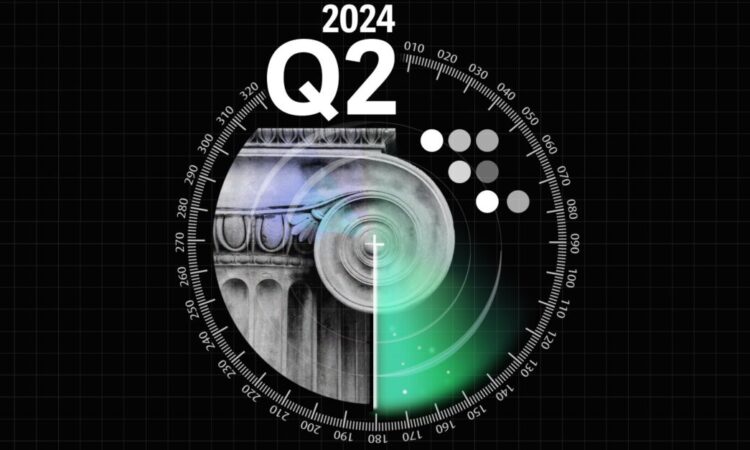
Scenarios
Baseline (70%): Real GDP growth slowed overall in the first quarter of 2024, coming in very close to our previous forecast’s expectations.2 We expect GDP growth will continue to moderate through the second half of this year and the start of the next, but the story is still positive overall. Consumer spending is forecasted to rise 2.3% this year, up from the 2.2% increase in 2023. Business investment is expected to increase 3% in 2024, down from 4.5% last year. Government spending is forecasted to rise 2.5%. Given that the US economy is expected to outperform many other global economies in the short term, we forecast imports to increase 3.1% on average in 2024, while exports are predicted to rise at a slower pace of 2.4%.
Consumer price index (CPI) inflation stays above the 3% threshold for the second quarter of this year before falling to 2.7% by the end of 2024. The Federal Reserve succeeds in walking the tightrope to a soft landing by cutting rates twice in the second half of 2024 and continues with cuts until reaching the neutral rate of 2.5% to 3% by 2027.
Job growth slows because current levels of job formation are not sustainable, given demographics and labor force participation. As a result, the unemployment rate falls in the short term, but rises to just under 4% in 2025 before gradually declining through the rest of the forecast period. Major investments prompted by the Inflation Reduction Act provide a boost to manufacturing.3 In addition, investments in intellectual property—such as the use of AI and other novel technologies—will continue to drive growth in the business sector.
Overall, we expect the US economy to post real GDP growth of 2.4% this year, but for growth to slow to 1.1% in 2025. Between 2026 and 2028, economic growth is expected to pick back up, with annual gains in real GDP forecasted to range between 1.6% and 1.9% per year.
Persistent inflation and geopolitical conflicts (20%): While our baseline remains positive, there are always downside risks to any forecast. We see risks centering around three interrelated issues: 1) geopolitical conflicts, 2) persistent inflation, and 3) financial system stress.
Major conflicts in Ukraine and the Middle East have been simmering for some time; either or both could flare up to a higher level. We see the most likely impact of such escalation coming in the form of higher prices of imported goods and oil. In this scenario, the price of oil spikes to around US$100 for three quarters before gradually declining.
Geopolitical conflicts are not just fought with guns. The past two American administrations have used tariffs and sanctions to varying degrees as tools to influence adversaries. The use of these tools can have an impact on the prices faced by American firms and consumers. In this scenario, we model tariffs that increase the cost of imported intermediate inputs by 1% and imported final goods by a further 1%.
As a result of the tariffs and the oil price shock, the Federal Reserve is driven to hike rates twice in the near term. Even with this action, CPI inflation persists above 3% until the second quarter of 2025.
The latest Federal Reserve Financial Stability Report4 highlights three near-term risks to the stability of the financial system: higher-for-longer interest rates; worsening geopolitical conflict and spillovers; and strains on real-estate markets, particularly for office real estate. In line with the other assumptions outlined above, we therefore model an increase in stress in the financial system.
In this scenario, GDP growth is lower than in the baseline scenario, particularly over the next two years. Growth in 2024 is 2.2%; by the following year, the tariffs are fully implemented, and growth in 2025 is just 0.6%. Growth averages 1.7% per year from 2026 to 2028.
A golden era for labor markets (10%): AI is today’s popular buzzword, but the increasing sophistication and availability of technology and software has already been replacing some jobs and creating new ones. This kind of transformation will continue—and since technological change is not always linear, there is always the possibility of fast changes that help boost productivity significantly. In this scenario, labor productivity grows at an average of 1.7% per year from 2024 through 2028, compared to 1.4% in the baseline.
In addition to the productivity dividend, population growth increases from an average of 1.8 million per year in the baseline to 1.9 million per year. As a result, the population will be 525,000 larger by 2028. Labor force participation rates will be higher than those in the baseline as older workers postpone retirement. With a larger population base as well as a workforce working longer over time, there will be more people looking for employment—and with demand remaining strong, they will find it. Total employment levels will rise, with faster growth in the outer years of the forecast.
In this scenario, GDP will rise faster than the baseline forecast over the entire forecast horizon. From 2024 through 2028, GDP will increase at an average annual rate of 2.2% per year, 0.5 percentage points higher than the baseline forecast. This scenario also results in higher long-term potential for the economy at 2.3%, compared to 1.7% in the baseline. In that sense, this scenario shows what it would take to make recent rates of economic growth sustainable in the long run.






